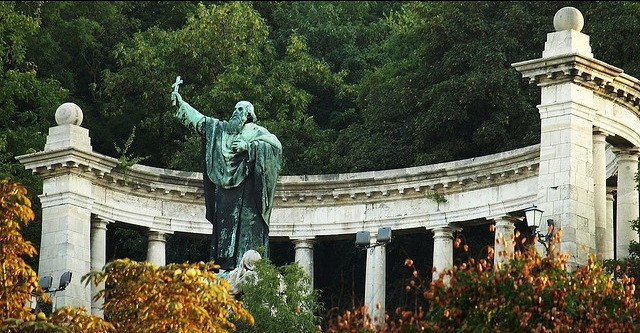Great pagan rebellion in 1046 – Gellért-Hill, Budapest
Fact of the Hungarian figure „St. Stephen and others – First christian saints in Hungarian Kingdom”
Part of the „The patrons and guardians of the land” topic
Gellért Hill in Budapest is a site of profound historical and spiritual significance, particularly in the context of the Great Pagan Rebellion of 1046. This uprising was a major challenge to the Christianization efforts initiated by St. Stephen, Hungary’s first king, and was driven by pagan factions within Hungary who opposed the rapid spread of Christianity.
The rebellion was led by Vata, a powerful lord of Békés castle and a chieftain in the Körös region. Although Vata had nominally embraced Christianity to retain his power, he reverted to his pagan roots at the first opportunity. His rebellion was likely sparked by King Peter’s aggressive actions, which included attempts to seize Békés castle and replace Vata with a loyal Christian comes. Vata rallied the discontented pagan masses, who opposed Peter’s reliance on Christianity and foreign allies, and sought to restore their traditional beliefs.
According to Hungarian chronicles, Vata dedicated himself to pagan gods and evil spirits, adopting pagan customs such as tying his hair in three braids and encouraging the consumption of horse meat—acts that symbolized a rejection of Christian norms. His uprising quickly spread across eastern Hungary, where the rebels demanded that the returning princes, the sons of Vazul, allow them to revert to paganism and kill the clergy. The princes, caught in a precarious position, were forced to acquiesce to these demands.
As the rebellion intensified, King Peter hastily crossed the Danube towards Székesfehérvár, while bishops and clerics, including Saint Gerard (Szent Gellért), set out from Székesfehérvár to greet the returning princes. The clerics were intercepted by Vata’s forces at the Pest ferry. It was here, on what is now known as Gellért Hill, that Saint Gerard and other bishops were brutally martyred. Gerard, in particular, was either stoned and speared or thrown from the cliffs in a two-wheeled cart, symbolizing the fierce opposition to Christianization.
Despite the temporary success of the rebellion, the martyrdom of Gerard and others became a powerful symbol of the ultimate triumph of Christianity in Hungary. The rebellion was eventually quelled, and Christianity continued to spread, with Gerard being canonized in 1083 alongside St. Stephen and other early saints. Gellért Hill, named in honor of Gerard, stands today as a monument to this pivotal moment in Hungary’s religious history, commemorating the struggle and eventual victory of the Christian faith in the face of adversity.





